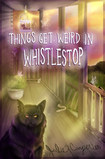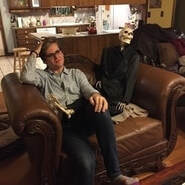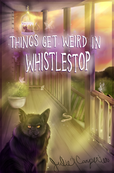Sacred Chickens
Menu
SACRED CHICKENS
 Guess what guys: Julie wrote a book! An actual book, with a title and a cover and everything! Cue ridiculous dancing around the kitchen. I may or may not have done the tango with my cat when I heard the news, and I can say that he was not appreciative of my creative expression. (I often think of my cats like orderlies in a mental asylum- they are arguably saner than I am, and they only stay to make sure I don’t try to fly off the roof. Whatever kitties, I still say it’s worth a try!) I have been reading the Whistlestop stories for about six years now – even before a few of them were published on Sacred Chickens - and to see them all come together in one book is really cool. There are so many things that I recognize from the book- places, people, and cats of course. Fair warning, this review may consist of glowing praise, long, meandering sentences about characters, and my usual ramblings, etc. I have a lot to say. Not only am I biased because Julie pays me (is there something in the contract about getting a raise for such a glowing review?), I also really like the book. I mean, it’s got witches and gardening in it, so I’m almost guaranteed to like it. All the stories fit together really well, and the narrative arcs nicely. I could go on and on and on for many pages about this book, but I’ve decided to try to keep it to four or five of my favorite stories. At least until I get that raise. (They’re sort of all my favoritse, but these are the ones I like the best at the moment. (There may be a few spoilers so what about buying the book and then reading this!) The first story of the book is that of Ida Fox May, a witch living in Whistle-stop in 1929. Ida May is chased to the home of Judge Clayton Silver, an angry mob of people accusing her of being a witch close at her heels. What are the qualities that suggest she’s a witch? She is not entirely accepted by the community and has power and knowledge that most men (and many of the women) do not have. For example, Julie wrote that, “Her self-possession, her bright dresses, her dark eyes and wild hair, something in the way she held herself separated her from them. She was not asked to join the Home Circle.” Now, as someone who has also never been asked to join the Home Circle, I can relate to that statement. I’m still waiting on my invitation from the church ladies. However, the common (by which I mean patriarchal) perception of witches is that they are a malevolent force, in league with the devil, blah blah blah. Because women who think for themselves are automatically evil. But, in all actuality, Ida is trying to help her community. She turns a boy into a kestrel but only to find a cure for something that’s tormenting him. She notes that sometimes magic is finicky, what can you do? I found this story really fascinating (actually I would like a whole book on Ida…hint, hint) because Ida’s story doesn’t have the typical ending we expect. The power balance in the typical story, male accuser versus female victim, doesn’t play out in the usual way. The Bite is one of the stories that really stuck with me. It’s about Mary Edelson and her hybrid tea roses (which is one of the things that Mrs. Green-thumbs talks about! Check it out here!). Hybrid tea roses can be a fussy bunch, requiring a good deal of maintenance, and a little help from chemicals. They are not necessarily comfortable in the wild order of nature. Mary’s hobby says something about her. Unfortunately for her, a fairy from the next garden over doesn’t care the pesticides she uses on her roses. I think that’s a really interesting idea- it’s almost as though nature is trying to correct the problem itself. If only. Mary doesn’t know or care that pesticides and the like are bad for the environment – like many people she is so focused on controlling the outcomes that she unthinkingly doses her plants, and the fairies, with the poison. (Healthy roses have been growing for thousands of years without the aids of pesticides, and the fact that many people feel the only way to have a healthy plant is to use them to me is an example of just how out of touch with the natural world we are. I’m really interested in this idea of how we manipulate nature and how we distance ourselves from it.) Mary uses pesticides and has her garden, “just so” and wants everything in her life to have the same kind of order. Just like Mary’s neighbor, Isabelle, in whose garden the fairies make their home, I prefer a garden with a wild side. A garden full of flowers and trees, a garden where unexpected things happen, where you don’t know exactly what’s around the corner. Not where everything is in its place, like a house where everything is staged just so, and feels unwelcoming and not lived in. Nature isn’t perfect or tame, so why should our gardens be? The description of the wilder, less, “perfect,” garden next door captures that feeling. It has giant butterfly bushes, and Mary is constantly fighting off the plants that encroach onto her picture-perfect lawn. Early in the story, Isabelle’s garden fights back in a very real way, when Mary is actually bitten by a fairy; the bite releases her inhibitions, all the things that have been restricting her- the obsession over perfection in her garden and the petty and mundane mediocrities that she reveled in. As things tend to do in Whistlestop, the situation goes slightly awry. Does Mary lose her mind or gain it? Different people in the community have different ideas. We have all have been Mary at some point or another, so caught up in everyday life that we forget that it actually doesn’t matter if your roses look perfect or not, and that Nature is not here to serve you. It’s an important thing to remember in a society that has forgotten. I cannot continue this review without mentioning Father Dingle. He’s the preacher at the local church, which happens to have a portal to hell in in the basement. In the choir room supply closet, of course. Inevitably, something wicked arrives through the portal, and havoc is wreaked. The messengers from Hell begin their work in the town, as if Whistlestop doesn’t get enough excitement as it is. The metaphor is there, certainly, but the story works. Father Dingle’s story is one in which he does not comport himself as well as he might have wished. Interestingly, when confronted with an aspect of his own beliefs, he has no way of handling it. He realizes that all the piety and prayer he spend his life practicing can’t prevent bad things from happening. The story is as much about the existential crisis of dealing with fear and evil as it is the physical damage sustained. Would I do the same if demons came out of my basement? Would you? (Or I would do something inane like ask them if they would like a cup of tea. Two splashes of fresh human blood with my sugar, if you please.) I really like this story and the allegorical aspects, and I like that the book examined it. I want more father Dingle! Finally, there’s Mr. Wilkerson. I loved him! If you’re familiar with his character, this might surprise you. He’s not the most likeable cat, but as someone who grew up with them (my future psychologist will probably say that this is the source of my problems) I can say that cats can be very sweet and then very….not. That’s just their way, keeping us on our toes. Mr. Wilkerson is featured throughout the book, but he features most prominently in the last story, The Cat Came Back. Now, I happen to know a certain black cat of Julie’s with a missing part of his ear that bears a strong resemblance to Mr. Wilkerson, and one can only hope that he doesn’t get fur all over the place, or bring you dead animals, or sit on the computer when you’re trying to write something very important. (Actually, Julie confirms that he has a few personality problems as well. Mr. Wilkerson is real, people, and I don’t know whether to be excited or terrified. I remember the Great Dead Mouse Incident of 2015, in which a partially decayed mouse was found behind a cabinet, perfuming Julie’s house, and I’ve suspected it was Crow, the model for Mr. Wilkerson, storing it for later. One can only imagine how many hiding places he has for his leftovers.) At any rate, to get back on track, Mr. Wilkerson might be my favorite character. You might think of him as a familiar, a guiding spirit that appears when he is needed the most (That means that we have to consider the possibility of ghost cats. Oh dear. They’ll be meowing for food in the middle of the night until kingdom come. Cat people really are lucky, aren’t we?) Mr. Wilkerson is also in many ways the giver and bearer of power. If you’ve got cats, you know this is true. He is a guide, but also a friend to the women he helps, even if he is obstreperous and gets fur everywhere. I’m very interested to see him in other stories, and what role he will play. I really enjoyed this book. Had it not been Julie’s, I feel like I would’ve found my way to it eventually. How could I ever resist a book about witches and gardening? The answer is that I can’t. The stories are, of course, very well written, and, like any good book, flow together nicely. It’s a book I didn’t want to put down and would’ve been perfectly happy to keep reading another 500 pages of. I am very much looking forward to the next book of Whistlestop stories, but in the meantime, you should pick this one up. If you don’t, the fairies just might have to bite you. You have been warned. Here's a link to IndieBound if you prefer to buy from local and independent bookstores.  Bio: Jarad is the co-administrator and writer for Sacred Chickens, attends college at MTSU, loves tea and coffee, and tries to spend every spare second reading. He recently developed an interest (some might say obsession) with gardening. Jarad is an English major with a concentration in literature. Bless his heart! Let's all light a candle for him and send him happy thoughts!
0 Comments
Leave a Reply. |

Click Photo above to buy ebook or paperback from Amazon.
Here's the link to Barnes and Noble Or order through your favorite independent bookstore! Categories
All
|
 RSS Feed
RSS Feed